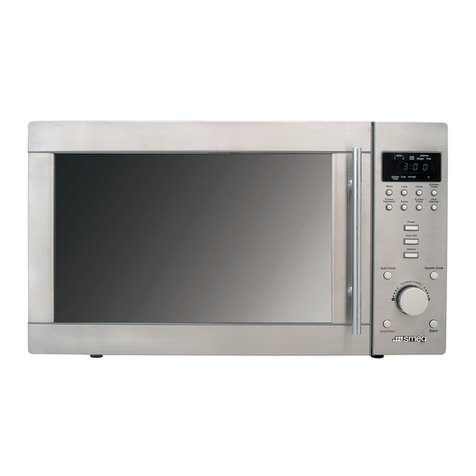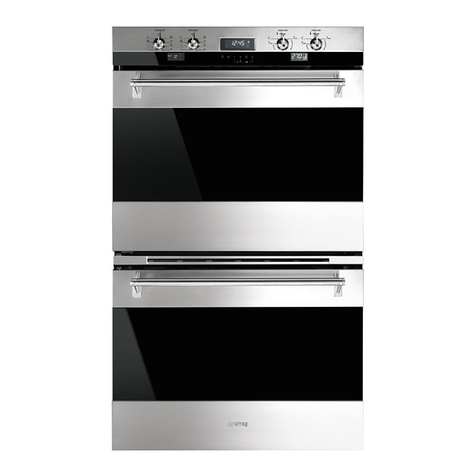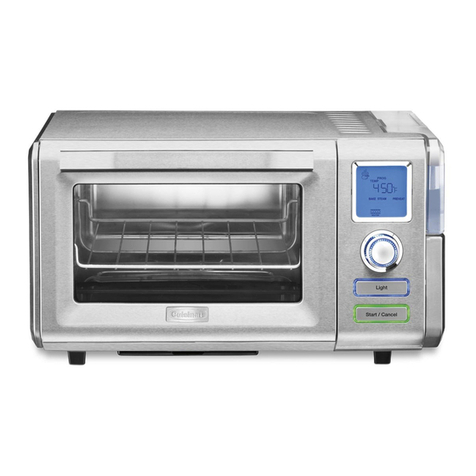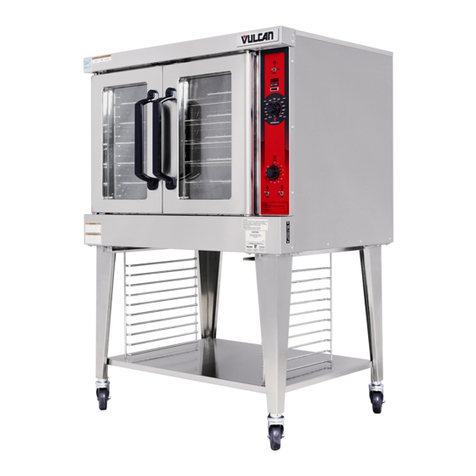BEING BOF Series User manual

Read manual before using this
product. Failure to do so and
observe this information can result
in injury or equipment damage.

Disclaimer
BEING Scientific Inc. makes no representations or warranties concerning this manual and, to the
maximum extent permitted by law, expressly limits its liability for breach of any warranty that may
be implied to the replacement of this manual with another. Furthermore, BEING reserves the right to
revise this publication at any time without incurring an obligation to notify any person of the revision.
The information provided in this documentation contains general descriptions and/or technical
characteristics of the instrument’s performance. This documentation is not intended as a substitute
for and is not to be used for determining suitability or reliability of these instruments for specific user
applications. It is the duty of any such user or integrator to perform the appropriate and complete
risk analysis, evaluation, and testing of the instruments with respect to the relevant specific application
or use thereof. Neither BEING nor its affiliates or subsidiaries shall be responsible nor liable for
misuse of the information contained herein. Please notify us if you have any suggestions for
improvements or amendments or have found errors in this publication.
All pertinent state, regional, and local safety regulations must be observed when installing and using
this instrument. Repair of BEING instruments SHALL BE PERFORMED IN CONSULTATION
with a BEING technical support representative by the instrument owner or their representative, or a
BEING authorized service technician.
The relevant instructions must be followed when instruments are used for applications with technical
safety requirements.
Copyright © 2023. BEING Scientific Inc.
All rights reserved. No part of this publication may be reproduced, distributed, or transmitted in any
form or by any means, including photocopying, recording, or other electronic or mechanical methods,
without BEING’s prior written permission. For permission requests, write to BEING, addressed
“Attention: Permissions Coordinator,” at the address below.
BEING Scientific Inc.
800 N Haven Ave., Suite 428
Ontario, CA 91764
T: +1 800.278.1390
www.beinglab-usa.com

BEING Scientific Inc.
BOF Mechanical Convection Oven Operating Instructions 3
Before Continuing
Please collect the following information from your unit. You’ll need it to
register the oven and activate its 2-year warranty and when you have to
contact customer or technical support.
Model Number:
Serial Number:
Production Date:
Firmware Version:
Dealer Purchased From:
Purchase Date:
STEP 1: Find the product identification label. STEP 2: Scan the QR code or visit to
https://www.beinglab-usa.com/product-registration
to register your oven(s).
Outside of the cardboard shell.
Back of the oven above the power cord.
2
YEAR
W
A
R
R
A
N
T
Y
Activate
!TODAY
Register Your Unit Today!
See section x.x.x on page xx for finding firmware version.
Thank you for purchasing BEING Scientific’s BOF series mechanical
convection oven.
BEING Scientific Inc. is committed to customer service both during and after the sale. If you have questions oncerning the
operation of your unit or the information in this manual, or the unit fails to operate properly, contact our Technology Support
Department at +1. 800.278.1390, or through the form on our website at https://beinglab-usa.com/technical-support.
Visit www.beinglab-usa.com/warranty for warranty details.

BEING Scientific Inc. BOF Mechanical Convection Oven Operating Instructions
4
Table of Contents
1.0 Safety Messages ............................................................................... 8 - 16
1.1 How to use the Manual........................................................................................ 8 - 9
1.1.1 Introduction ................................................................................................... 8
1.1.2 Chapter Summary.......................................................................................... 8
1.1.3 Model Number Nomenclature ....................................................................... 9
1.2 Safety Notice.............................................................................................................9
1.3 Symbols used in this Operation Instructions ............................................................ 10
1.3.1 Signal Word Panels ..................................................................................... 10
1.3.2 Safety Symbols ........................................................................................... 10
1.3.3 Miscellaneous Non-safety Symbols used in Manual ..................................... 11
1.4 Where to Locate Safety Labels on the Ovens ......................................................... 12
1.4.1 BOF-30T through BOF-200T ....................................................................... 12
1.4.2 BOF-400T ................................................................................................... 12
1.5 Precautions for Your Oven ............................................................................... 13 - 14
1.5.1 Warning Statements .................................................................................... 13
1.5.2 Caution Statements .................................................................................... 14
1.5.3 NOTICE Statements..................................................................................... 14
1.6 Responsibility ...................................................................................................15 - 16
1.6.1 General Responsibility ................................................................................. 15
1.6.2 Operator Responsibility ............................................................................... 15
1.6.3 Maintenance Responsibility ......................................................................... 16
1.6.4 Reporting a Safety Defect ............................................................................ 16
2.0 Functional Description ..................................................................... 17 - 29
2.1 Introduction ........................................................................................................... 17
2.2 Oven Generation Comparison ................................................................................ 18
2.3 Oven Features..................................................................................................19 - 29
2.3.1 Compliance ................................................................................................. 19
2.3.2 Construction .........................................................................................20 - 29
2.3.2.1 BOF-30T, BOF-50T, BOF-120T & BOF-200T ...........................20 - 21
2.3.2.2 BOF-400T ............................................................................. 22 - 23
2.3.2.3 Control System .............................................................................. 24
2.3.2.4 Component Functionality .........................................................25 - 29
3.0 Installation and Setup ....................................................................... 30 - 39
3.1 Inspecting and Uncrating ..................................................................................30 - 31
3.1.1 Inspecting Oven’s Packaging Before Removal ............................................. 30
3.1.2 Removing Oven from Shipping Container .............................................30 - 31
3.1.3 Inspect Oven after Packaging Removal ....................................................... 31
3.1.4 In the Event of Shipping Damage ................................................................ 31
3.2 Preparing the Location .....................................................................................32 - 34
3.2.1 Space Requirements ............................................................................32 - 33
3.2.2 Oven Environment ....................................................................................... 34
3.3 Oven Setup ......................................................................................................35 - 39
3.3.1 Stacking Ovens (BOF-50T & BOF-120T only) .............................................. 35
3.3.2 Preparing Oven for Use.........................................................................36 - 37
3.3.3 Setting Controller Date and Time ..........................................................38 - 39

BEING Scientific Inc.
BOF Mechanical Convection Oven Operating Instructions 5
4.0 Operation ........................................................................................ 40 - 61
4.1 Controller Display Overview ..............................................................................40 - 44
4.1.1 Current Conditions................................................................................40 - 41
4.1.2 Buttons .................................................................................................41 - 43
4.1.2.1 Multi-function Buttons..............................................................41 - 42
4.1.2.2 Single-function Buttons................................................................... 43
4.1.3 Data Collection............................................................................................. 43
4.1.4 Setting Entry Methods.................................................................................. 44
4.2 Changing Unit of Measurement ........................................................................45 - 46
4.3 Calibration .......................................................................................................47 - 49
4.3.1 Testing for TV1and TV2.........................................................................47 - 48
4.3.2 The Math ..................................................................................................... 49
4.3.3 Programming the Correction ....................................................................... 49
4.4 Selecting Program Mode ........................................................................................ 50
4.5 Setting Fixed-value Program ............................................................................51 - 52
6.5.1 Temperature ................................................................................................ 51
6.5.2 Program RUN Time ..............................................................................51 - 52
6.5.3 Fan Speed ................................................................................................... 52
4.6 Multi-step Programs.........................................................................................53 - 55
4.6.1 What is a Multi-step Program ....................................................................... 53
4.6.2 Setting Program Steps .........................................................................54 - 55
4.6.3.1 Program Step Temperature Setpoint ............................................... 54
4.6.3.2 Program Step Fan Speed .............................................................. 54
4.6.3.3 Program Step RUN Time ................................................................ 55
4.6.3 Program Cycling ...................................................................................56 - 57
4.6.3.1 Overview ......................................................................................... 56
4.6.3.2 Setting Number of Cycles ........................................................56 - 57
4.7 Setting RUN/START Delay Timer .......................................................................58 - 59
4.7.1 Overview...................................................................................................... 58
4.7.2 Programming RUN/START Delay Timer ................................................58 - 59
4.8 Setting Low-temperature & High-temperature Alarms .......................................60 - 61
5.0 Data Collection ................................................................................ 62 - 66
5.1 Overview .................................................................................................................62
5.2 Storage Capacity ..................................................................................................... 63
5.3 Viewing Data ....................................................................................................63 - 64
5.4 Exporting Data ..................................................................................................64 - 66
5.4.1 File Types ..................................................................................................... 64
5.4.2 Collecting Data During Program Run ........................................................... 65
5.4.3 Collecting Data History by Date.................................................................... 66
5.4.3 Collecting Data History by Number of Program Starts or Power-ons ............ 66

BEING Scientific Inc. BOF Mechanical Convection Oven Operating Instructions
6
6.0 Operational Settings Screens and Parameters .................................. 68 - 85
6.1 Overview (Home Screen) ......................................................................................... 68
6.2 USER Settings .................................................................................................69 - 77
6.2.1 Screen 0 | USER Home Screen ................................................................... 69
6.2.2 Screen 1 | History - Table ............................................................................. 70
6.2.3 Screen 1 | Present Value vs Setpoint Curve - Real Time .............................. 71
6.2.4 Screen 1 | Alarm History (Generation 3 only) ................................................ 72
6.2.5 Screen 2 | Date and Time Settings .............................................................. 74
6.2.6 Screen 3 | tM, Po, Cycle, Delay Parameters ................................................ 75
6.2.7 Screen 4 | AL, Pb, PK, PA Parameters ........................................................ 76
6.2.8 Screen 5 | 2b, 2K Parameters ..................................................................... 77
6.3 SERVICE Settings ...........................................................................................78 - 85
6.3.1 Screen 1 | P, I, d, t Parameters .................................................................... 78
6.2.2 Screen 2 | CL, Ct, Ht, Lt Parameters ........................................................... 79
6.3.3 Screen 3 | Hp, Co Parameters ..................................................................... 80
6.3.4 Screen 4 | dr, Fn, md, La Parameters .......................................................... 81
6.3.5 Screen 5 | LI, wA, HC, Yu Parameters ......................................................... 82
6.3.6 Screen 6 | ET, CF, F1, F6 Parameters .......................................................... 83
6.3.7 Screen 7 | F7, F8, Mu, Ot Parameters ......................................................... 84
6.3.8 Screen 8 | FA, uC, Mn, 2T Parameters ........................................................ 85
7.0 Troubleshooting and Maintenance .................................................... 86 - 88
7.1 Troubleshooting ...................................................................................................... 86
7.2 Preventive Maintenance ...................................................................................87 - 88
7.2.1 Calibration ................................................................................................... 87
7.2.2 Cleaning ...............................................................................................87 - 88
7.2.2.1 Cleaning the Exterior ....................................................................... 87
7.2.2.2 Cleaning the Chamber .................................................................... 87
7.2.2.3 Cleaning the Electronics ................................................................. 88
7.2.2.4 Cleaning Before Returning Unit ....................................................... 88
7.2.3 Storage ....................................................................................................... 88
8.0 Appendix .......................................................................................... 90 - 98
8.1 Specifications ......................................................................................................... 90
8.2 Electrical Wiring Schematics.............................................................................91 - 93
8.2.1 BOF-30T through BOF-200T (Generation 1)................................................. 91
8.2.2 BOF-30T through BOF-200T (Generations 2 & 3)......................................... 92
8.2.4 BOF-400T (Generations 2 & 3) .................................................................... 93
8.3 Certification and Certificates .............................................................................94 - 96
8.3.1 ISO-9001 Certificate ..................................................................................... 94
8.3.2 ETL Certificate .............................................................................................. 95
8.3.3 Certificate of Calibration ................................................................................ 96
8.4 Statements ............................................................................................................. 97
8.4.1 Oven Ventilation ............................................................................................ 97
8.4.2 California Proposition 65 ............................................................................... 97
8.4.3 Waste Disposal ............................................................................................. 97
8.4.3.1 Packaging....................................................................................... 97
8.4.3.2 Unit ................................................................................................. 97
8.5 Warranty ................................................................................................................. 98

BEING Scientific Inc.
BOF Mechanical Convection Oven Operating Instructions 7

BEING Scientific Inc. BOF Mechanical Convection Oven Operating Instructions
8
1.0 Safety Messages
1.1 How to use These Operating Instructions
1.1.1 Introduction
This manual is intended for individuals requiring information about the use of mechanical (forced air)
convection ovens. Use these operating instructions as a guide and reference for installing, operating,
and maintaining your BEING BOF series, mechanical (forced air) convection ovens (hereinafter “oven”
or “unit”). The purpose is to assist you in applying efficient, proven techniques that enhance
equipment productivity.
These operating instructions covers only light corrective maintenance. No installation, service
procedure or other maintenance should be undertaken without first contacting a service technician,
nor should be carried out by someone other than a service technician with specific experience with
laboratory equipment and electricity.
1.1.2 Chapter Summary
The Installation chapter includes the pertinent information for receiving, unpacking, inspecting, and
setting up the unit. This section contains instructions that should be followed before operating the
oven. These instructions are intended to supplement standard laboratory procedures performed daily
and weekly.
The Functional Description chapter outlines the oven’s standard and safety features.
The Operation chapter includes a description of controller features, temperature, time, and fan speed
setting instructions, multi-segment program setting instructions, and instructions for changing the unit
of measurement and calibrating the oven.
The Data Logging chapter is intended to serve as a source for understanding how the oven’s
controller collects temperature and time information during the oven’s operation and how the user can
collect this data for analysis.
The Operational Settings Screens and Parameters chapter provides the user with all the screens for
viewing real-time temperature and time performance data and data and alarm history. Additionally, it
includes information on navigating the screens and settings that affect the oven’s accuracy, efficiency,
and effectiveness, along with changing the unit of measurement.
The Troubleshooting and Preventive Maintenance chapter serves as a guide for identifying the most
common problems. Potential problems are listed, along with possible causes and related solutions.
The Appendix contains technical specifications, schematic drawings, warranty, certification certificates,
instructions for requesting a certificate of calibration and for end-of-life disposal of the unit, and BEING
technical support contact information.

BEING Scientific Inc.
BOF Mechanical Convection Oven Operating Instructions 9
1.2 Safety Notice
Be sure that you are completely familiar with the safe operation of the BEING BOF series oven. Improper use can
cause serious or fatal injury.
Installation and repair procedures require specialized skills with laboratory equipment and electricity. Any person
that installs or repairs this unit must have these specialized skills to ensure that this unit is safe to operate.
Contact BEING Scientific Inc. or your local authorized distributor for repairs or any questions you may have about
this unit’s safe installation and operation.
The precaution statements are general guidelines for the safe use and operation of these instruments. It is not
practical to list all unsafe conditions. Therefore, if you use a procedure that is not recommended in these operating
instructions, you must determine if it is safe for the operator and all personnel in the proximity to the instrument.
If there is any question of the safety of a procedure, please contact BEING Scientific before starting or stopping
the instrument.
This equipment contains high voltages. Electrical shock can cause serious or fatal injury. Only qualified personnel
should attempt the startup procedure or troubleshoot this unit.
• Documentation must be available to anyone that operates this equipment at all times.
• Keep non-qualified personnel at a safe distance from this unit.
• Only qualified personnel familiar with the safe installation, operation, and maintenance of this unit should
attempt startup or operating procedures.
• Always stop the instrument before making or removing any connections.
1.1.3 Model Number Nomenclature
These operating instructions covers all five (5) models of the BEING BOF series. The following
describes the model number nomenclature used throughout these instructions.
B O F - 30 T
BEING
Instrument
O = Oven
Instrument Type
F = Mechanical (forced air) convection
Controller
T = Touchscreen
Chamber Size
30 = 30L
50 = 51L
120 = 121L
200 = 211L
400 = 400L

BEING Scientific Inc. BOF Mechanical Convection Oven Operating Instructions
10
1.3 Symbols used in These Operating Instructions
The following signal word panels, safety symbols, and non-safety symbols are used to alert you to potential per-
sonal injury hazards or information of importance. Obey all safety messages that follow these symbols to avoid
possible personal injury or death.
1.3.1 Signal Word Panels
Signal word panels are a method for calling attention to a safety messages or property damage
messages and designate a degree or level of hazard seriousness. It consists of three elements: a
safety alert symbol, a signal word and a contrasting rectangular background. The following signal
word panels are in accordance with ANSI Z535.4-2111 (R2017) and ISO 3864 standards.
Indicates a hazardous situation which, if not avoided,
will result in death or serious injury.
Indicates a hazardous situation which, if not avoided,
could result in death or serious injury.
Indicates a hazardous situation which, if not avoided,
may result in minor or moderate injury.
Indicates a property damage message.
1.3.2 Safety Symbols
Safety symbols are graphic representations—of a hazard, a hazardous situation, a precaution to avoid
a hazard, a result of not avoiding a hazard, or any combination of these messages—intended to
convey a message without the use of words. The following safety symbols are used in these
operating instructions.
Mandatory
General Mandatory Symbol
General Notice Symbol Read Manual Earth Ground
Multi-person Lift Disconnect Electric Plug
From Outlet
Disconnect Before
Maintenance or Repair
Wear Face Mask Wear Eye Protection Wear Protective Gloves

BEING Scientific Inc.
BOF Mechanical Convection Oven Operating Instructions 11
1.3.3 Miscellaneous Non-safety Symbols used in Manual
The following graphic representations are intended to convey a message without words or to bring
your attention to important information about the use of the oven or a feature.
Warning
Prohibition
Read Information Ambient Temperature Atmospheric Pressure
Relative Humidity Airborne Pollution ETL Certification
Waste Electrical and
Electronic Equipment
No Direct Sunlight No Radiant Heat Exposure No Corrosive
Fuids or Cleaners
No Explosive Gases No Flammable Gases No Water
General Warning Symbol
Safety Alert Symbol Electrical Shock Hand Crush or Pinch
Lifting Hazard Hot Surface

BEING Scientific Inc. BOF Mechanical Convection Oven Operating Instructions
12
The safety labels are attached to the ovens to provide important information about potential hazards and how
to avoid them. The following photos show where the safety labels should be attached to the oven until service
of the product is discontinued. If the safety labels are damaged, please contact BEING or your local distributor
to request new labels.
1.4 Where to Locate Safety Labels on the Ovens
1.4.1 BOF-30T through BOF-200T
1.4.2 BOF-400T
1
2
1
2
12
Figure 1.1 Figure 1.2
Figure 1.3 Figure 1.4
Figure 1.5
Figure 1.6

BEING Scientific Inc.
BOF Mechanical Convection Oven Operating Instructions 13
1.5.1 Warning Statements
The improper use of this unit may cause death or serious injury. Observe all statements.
DO NOT remove warning labels.
Check the voltage, phase and capacity of the power supply and connect properly.
Check the voltage and frequency of the power supply and ensure they are compatible with the oven
power requirements prior to use. The fluctuations of the supply voltage SHALL NOT exceed ±10%
of the nominal supply voltage.
This unit MUST use the included electrical cord with a dedicated electrical circuit with a confirmed
electrical ground connection.
The unit MUST BE properly electrically grounded (The Hot line or the Neutral line SHOULD NOT be the
grounded connection, adhere to the product’s requirement before using).
Please use the receptacle connecting with the ground connection to prevent electric shock. If the
receptacle does not have the ground connection, the earth ground wire must be installed by a qualified
electrician. DO NOT conduct the ground connection through the gas pipe, water pipe, telephone line
or lightning rod! This kind of ground connection may cause electric shock due to the incomplete loops.
DO NOT insert multiple plugs into the outlet at the same time.
Power switch and circuit breaker MUST be in the “OFF” position when connecting or disconnecting
the unit’s power cord to or from the power supply.
The power cord MUST BE removed from receptacle when any of the following occur:
• When the product is waiting for overhaul due to faults.
• When the product goes out of service for a long time.
• When the product is being moved.
DO NOT operate oven with damaged power cords.
DO NOT arbitrarily lengthen or shorten the power supply connection wire.
DO NOT modify the power cord in any way.
DO NOT put flammable, explosive, volatile, and corrosive substances in the oven chamber for drying
and baking.
DO NOT touch the chamber door, the chamber body or the surrounding surface when the set
temperature is over 176°F (80°C)!
DO NOT put fingers, hands or objects into the air intake or exhaust ports.
The unit should have routine inspections and should be serviced by a qualified service technician
when needed.
Our oven is designed to provide safe and reliable operation when installed and operated within design
specifications. Make sure you read and understand all instructions and safety precautions listed in this
manual before installing or operating your unit. If you have any questions concerning the operation of your
unit or the information in this manual, contact our Technical Support Department.
To avoid possible personal injury or equipment damage when installing, operating, or maintaining this oven,
use good judgment and follow these safe practices:
1.5 Precautions for Your Oven

BEING Scientific Inc. BOF Mechanical Convection Oven Operating Instructions
14
1.5.2 Caution Statements
The improper use of this unit may result in minor or moderate injury.
DO NOT use doors, handles or knobs to lift or stabilize the unit.
DO NOT place heavy objects on the power cord.
DO NOT put the oven on the power cord.
DO NOT tension the power supply cord when plug in.
DO NOT operate oven when water may be in the unit. Immediately disconnect the main power
supply and request service.
DO NOT sprinkle insecticide or flammable spray on the oven.
1.5.3 NOTICE Statements
The improper use of this unit may result in damage to the unit or your facility.
The oven should be located on a strong solid surface.
Take care when opening and closing the door to prevent damage to delicate internal components.
DO NOT make the oven wet while cleaning.
DO NOT pour water or put liquid on the oven when cleaning the unit.
DO NOT clean the oven with a strong cleanser (e.g., solvent type) and use a soft cloth.
304 stainless steel material is not acid resistance, please pay attention to the corrosion prevention
measures. DO NOT place corrosive materials inside the unit to prevent damage.
In addition to the safety warnings listed above, safety messages are posted throughout the manual.
These safety messages are designated using a signal word panel followed by text and a safety symbol
where applicable. Read and follow these important instructions. Failure to observe these instructions
can result in permanent damage to the unit, significant property damage, personal injury or death.

BEING Scientific Inc.
BOF Mechanical Convection Oven Operating Instructions 15
Our ovens are constructed for maximum operator safety when used under standard operating conditions and
when recommended instructions are followed in the maintenance and operation of the machine.
All personnel engaged in the use of the oven should become familiar with its operation as described in these
operating instructions.
Proper operation of the unit promotes safety for the operator and all workers in its vicinity.
Each individual must take responsibility for observing the prescribed safety rules as outlined. All caution,
warning and danger labels must be observed and obeyed. All actual or potential danger areas must be
reported to your immediate supervisor.
1.6 Responsibility
1.6.1 General Responsibility
No matter who you are, safety is important. Owners, operators, and maintenance personnel must
realize that safety is a vital part of their jobs every day.
If your primary concern is loss of productivity, remember that production is always affected negatively
following an accident. The following are some of the ways that accidents can affect your production:
• Loss of a skilled operator (temporarily or permanently)
• Breakdown of lab morale
• Costly damage to equipment and laboratory samples
• Downtime
An effective safety program is responsible and economically sound.
Organize a safety committee or group and hold regular meetings. Promote this group from the
management level. The safety program can be continually reviewed, maintained, and improved through
this group. Keep minutes or a record of the meetings.
Hold daily equipment inspections in addition to regular maintenance checks. You will keep your
equipment safe for production and exhibit your commitment to safety.
Please read and use these operating instructions as a guide to equipment safety. These instructions
contain safety warnings throughout, specific to each function and point of operation.
1.6.2 Operator Responsibility
The operator’s responsibility does not end with efficient experimentation and production. The operator
usually has the most daily contact with the equipment and intimately knows its capabilities and limitations.
Plant and personnel safety is sometimes forgotten in the desire to meet incentive rates, or through a
casual attitude toward laboratory equipment formed over a period of months or years. Your employer
probably has established a set of safety rules in your workplace. Those rules, these operating instructions,
or any other safety information will not keep you from being injured while operating your equipment.
Learn and always use safe operation. Cooperate with co-workers to promote safe practices. Immediately
report any potentially dangerous situation to your supervisor or appropriate person.

BEING Scientific Inc. BOF Mechanical Convection Oven Operating Instructions
16
REMEMBER:
• NEVER place your hands or any part of your body in any dangerous location.
• NEVER operate, service, or adjust the equipment without appropriate training and first reading
and understanding this manual.
• Before you start the portable drying/conveying system check the following:
Remove all tools from the oven.
Be sure no objects, samples or chemicals are laying on the oven.
• If your oven has been inoperative or unattended, check all settings before starting the unit.
• At the beginning of your shift and after breaks, verify that the oven is functioning properly.
• Report the following occurrences IMMEDIATELY:
unsafe operation or condition
unusual oven action
leakage
improper maintenance
• DO NOT wear loose clothing or jewelry, which can be caught while working on the equipment. In
addition, cover or tie back long hair.
• Clean the equipment and surrounding area DAILY, and inspect the machine for loose, missing or
broken parts.
• Shut off power to the oven when it is not in use. Turn the power switch to the OFF position, or
unplug it from the power source.
1.6.3 Maintenance Responsibility
Proper maintenance is essential to safety. If you are a maintenance worker, you must make safety a
priority to effectively repair and maintain equipment.
Before removing, adjusting, or replacing parts on this oven, remember to turn off all electric supplies
and all accessory equipment at the machine, and disconnect and lockout electrical power. Attach
warning tags where possible.
Be sure the oven is correctly connected to an earth grounded electrical outlet that
complies with current codes.
When you have completed the repair or maintenance procedure, check your work, and remove your tools.
DO NOT restore power to the oven until all persons are clear of the area. BEFORE you turn the oven
over to the operator for production, verify the unit is functioning properly.
1.6.4 Reporting a Safety Defect
If you believe that your oven has a defect that could cause injury, you should immediately discontinue
its use and inform BEING Scientific or your local authorized distributor.
The principle factors that can result in injury are failure to follow proper operating procedures
(i.e. lockout/tag out), or failure to maintain a clean and safe working environment.

BEING Scientific Inc.
BOF Mechanical Convection Oven Operating Instructions 17
The BEING BOF Series mechanical (forced air) convection ovens are engineered for heavy workloads and
continuous, 24-hour operation in a wide variety of chemistry, clinical, light industrial, pharmaceutical, and
research laboratory applications, such as.
• Age testing of electronic components and devices, AKA product age acceleration
• Annealing
• ASTM testing
• Baking
• Conditioning
• Curing
• Dehydrating
• Die-bonding
• Dry sterilization
• Evaporation
• Drying - glassware and part
• Heat treating
• Heated storage
• Life cycle testing
• Moisture and stability tests
• Polymerization
• Pre-heating
The mirror-finish 304 stainless steel chamber provides a strong, corrosion-resistant, inert, and easy-to-
clean environment and prevents sample contamination for any application. The wire shelves provide
maximum air circulation for uniform heating. Their design prevents shelf-tilting and sample spillage. The
wire’s surface tension minimizes or eliminates sample- or part-slide.
The microprocessor-based PID temperature controller and 3-speed, forced convection heating system
provide uniform temperature regulation without overshoot, eliminating potential sample damage. The
controller provides for the programming and storage of fixed-value and multi-segment programs. (See
Section 4.0 for controller programming.)
The adjustable exhaust allows the user to control chamber temperature uniformity by allowing humidity
to escape.
System risks, like voltage spikes, short circuits, over temperature, etc., are monitored by a safety system
that runs independently of the performance controller. Audible and visual alarms are set off, and the oven
will shut down if a risk is identified.
The BOF Series ovens have a USB communications port for data logging. (See Section 5.0 for extracting
data information.)
2.0 Functional Description
2.1 Introduction

BEING Scientific Inc. BOF Mechanical Convection Oven Operating Instructions
18
Since the introduction of the BOF Series mechanical (forced air) convection ovens with
a touchscreen controller display was introduced in 2021, it has gone through several
improvement cycles. The following table shows the differences in the oven generations.
The feature descriptions and operational instructions in this document cover the three
generations of ovens.
Feature Generation 1 Generation 2 Generation 3
Manufacturing Date - Start Jan 2023
Electrical
Integrated electrical panel with easy access cover •••
Circuit breaker over-current protection - power switch
combination •––
Circuit breaker current protection –••
Illuminated power switch –••
Resistive heating element •••
Controller
Touch capactive display •••
PID automatic control •••
Automatic power on/off •••
USB data collection •••
Firmware updatable •••
Programmable functions
Unit of measurement •••
Oven temperature calibration •••
Fixed-value programs •••
Multi-step programs •••
Program cycling •••
Timed & untimed •••
Fan speed - adjustable •••
RUN delay •••
Alarm notification
On display •––
Alarm history in operational settings –••
Heating element on indicator ––•
User interface version ––•
Safety
Resettable over-temperature switch
Reset button inside electrical panel ••–
Reset button outside electrical panel ––•
Temperature limit protection •••
Power off memory •••
Anti-scalding protection •••
2.2 Oven Generation Comparison

BEING Scientific Inc.
BOF Mechanical Convection Oven Operating Instructions 19
2.3 Oven Features
2.3.1 Compliance
The BEING BOF series mechanical (forced air) convection ovens have been
tested and found to be in compliance with the requirements defined in IEC
61010: Medical Laboratory Equipment Testing.
Compliance can be identified by the ETL INTERTEK mark on the product
identification label above the power cord. The testing has demonstrated.
5000103
CONFORMS TO:
UL 61010-1:2012 | Edition 3.1 | R2019: Safety requirements for electrical equipment for measure-
ment, control, and laboratory use – Part 1: General requirements
UL 61010-2-010:2019 | Edition 4: Safety requirements for electrical equipment for measurement,
control and laboratory use – Part 2: Particular requirements for laboratory equipment for the heating
of materials
CERTIFIED TO:
CAN/CSA 22.2 61010-1-12:2012 | Edition 3+ U1; U2; A1: Safety requirements for electrical
equipment for measurement, control, and laboratory use – Part 1: General requirements
CAN/CSA 22.2 61010-2-010:2019 | Edition 4: Safety requirements for electrical equipment for
measurement, control and laboratory use – Part 2: Particular requirements for laboratory equipment
for the heating of materials

BEING Scientific Inc. BOF Mechanical Convection Oven Operating Instructions
20
2
3
8
9
5
6
10
11
17
16
18
15
9a
19
14
20
13
12
Front View
Front Left Isometric View
Back View - Generation 3
2 Chamber door
3 Door handle/latch
5 Top door hinge & hinge cover
6 Bottom door hinge
8 Touchscreen controller display with
USB data collection port
9 Feet
1 Body
10 Electrical components access panel
11 Power switch (Generation 2 & 3 units only)
9a Stacking feet (BOF-50T & BOF-120T only)
12 Power cord
13 Circuit breaker (Generations 2 & 3)
Circuit breaker/power switch
(Generation 1)
14 Over-temperature switch reset
button (Generation 3, see Section 2.3.2.3 for
Generations 1 & 2.)
15 Chamber air intake
16 Chamber exhaust vent
17 Back panel
18 Fan vent
19 Electrical panel vent
20 Product identification label
2.3.2 Construction
2.3.2.1 BOF-30T through BOF-200T
20
13
12
Back View
Close-up
Generations 1 & 2
Figure 2.1
Figure 2.2
Figure 2.3
1
This manual suits for next models
5
Table of contents
Popular Convection Oven manuals by other brands

turbofan
turbofan E9311 Installation & operation manual

Wolf
Wolf ML-136825 owner's manual

turbofan
turbofan 30D Series Installation and operation manual
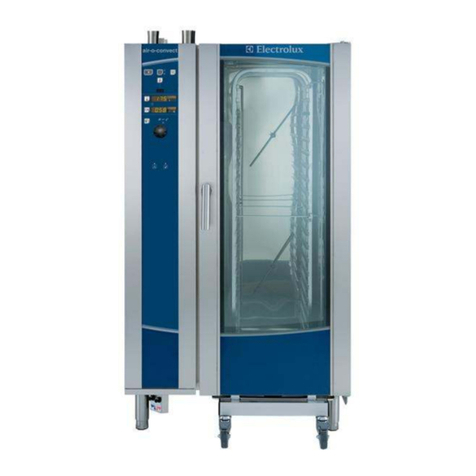
Electrolux
Electrolux air-o-convect LPG Gas Hybrid Convection Oven... Short form specification

Healthy Choice
Healthy Choice PR4225 manual
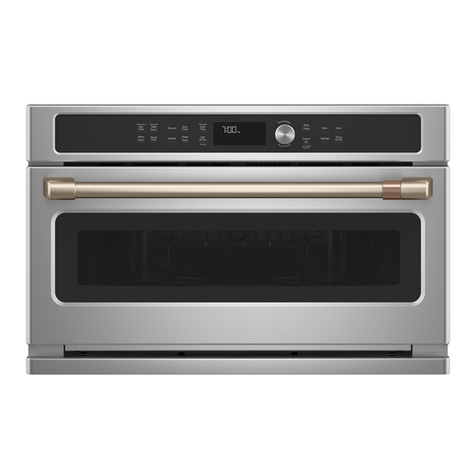
GE
GE Advantium CWB713 installation instructions


